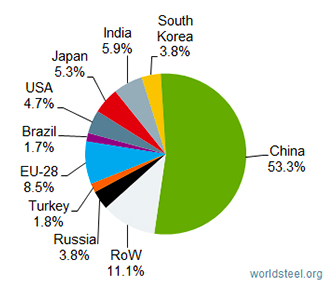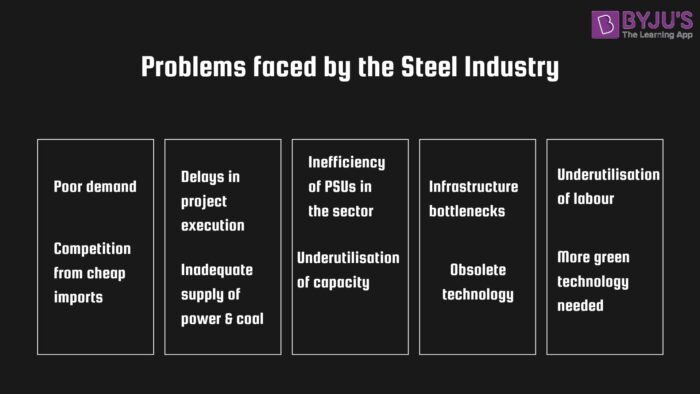The National Steel Policy, 2017 was given cabinet approval in 2017 by the Government of India. The NSP, 2017 is a comprehensive document detailing the targets to achieve in the steel sector for the country. In this article, you can read all about the National Steel Policy, 2017 for the UPSC and other government exams.
National Steel Policy (NSP):- Download PDF Here
What is the National Steel Policy?
The National Steel Policy which was released in 2017 aims to attain a steel production capacity in India of 300 MT by 2030. It has a long-term vision to enhance domestic consumption, produce high-quality steel and make the sector globally competitive.
NSP, 2017 Vision
- To create a globally competitive steel industry that promotes inter-sectoral growth.
The policy’s mission is to create an environment that enables:
- Self-sufficiency in the production of steel by giving policy support and guidance to MSME producers of steel, the private sector, central public sector enterprises and boost sufficient capacity additions.
- Development of internationally competitive manufacturing capabilities.
- Increase in the domestic demand for steel.
- Cost-efficient production and domestic availability of iron ore, coking coal and natural gas.
- Investment in overseas asset acquisitions of raw materials.
National Steel Policy Objectives
The stated objectives of the NSP, 2017 are mentioned under this section.
- Increase the crude steel capacity to 300 MT by 2030-31.
- Increase per capita consumption of steel to 160 kg by 2030-31. (Current consumption (2017) is only 69 kg).
- Meet through domestic production the whole demand for high-grade automotive steel, special steels and alloys, and electrical steel for strategic applications by 2030-31.
- Become a net steel exporter by 2025-26.
- Increase domestic availability of washed coking coal so as to reduce import dependence on coking coal to 50% by 2030-31.
- Develop & implement quality standards for domestic steel products.
- Assist the industry to a global leader on energy and raw material-efficient steel production by 2030-31.
National Steel Policy Background
The steel industry is a very important one for the economy as a whole. It is the backbone of any industrial economy. Steel finds widespread applications in many sectors such as construction, power, infrastructure, aerospace, consumer products, industrial machinery and so on. The steel industry has strong forward and backward linkages in terms of material flows and income generation.
The Indian steel sector has grown dramatically over the past few years to be the third-largest producer of steel globally, contributing to about 2% of the country’s GDP and employing about 5 lakh people directly and about 20 lakh people indirectly.
- A flourishing steel industry is crucial for a country’s rapid economic growth and industrial development.
- Prior to deregulation in 1991-92, the steel capacity of the country was only 22 MT. From there, currently, the country has grown to be the second-largest producer of steel with a production of 91 MT and a production capacity of 122 MT in 2015-16.
- India’s competitive advantage in steel production is driven, to a large extent, by the indigenous availability of high-grade iron ore and non-coking coal – the two critical inputs of steel production. Additional factors are a large consumer market for steel, a young workforce with competitive labour costs, and a strong MSME sector.
- The sector is a big contributor to the growth of the manufacturing sector.
A few facts related to steel production
- China is the world’s largest producer of crude steel accounting for more than 51 per cent of production.
- In 2019, India replaced Japan as the second-largest producer of crude steel which was at 106.5 MT (a hike by 4.9 % from 101.5 MT in 2017).
- Other countries in the top ten steel producers include the USA, Russia, South Korea, Germany, Brazil, etc.
- The above facts are as published by the World Steel Association.
The below pie chart will show the country-wise share in steel production for the year 2019:

Image courtesy worldsteel.org
Also read: National Fisheries Policy, 2020
Steel Sector Development in India
The economic liberalization of the 1990s helped the steel sector grow rapidly in the country.
- Licensing requirement for capacity creation was done away with, except for certain locational restrictions.
- The steel sector was privatised and was taken off from the list of industries that were reserved for the public sector.
- Foreign equity investment up to 100% was granted automatic approval.
- Price and distribution controls were removed. This helped the steel industry become more efficient and competitive.
- Price regulation was abolished in 1992 and since then, the prices have been fixed by market forces.
- 18% GST is applicable on steel.
- There is no export duty on steel products.
- The government has constituted a Steel Price Monitoring Committee to monitor price rationalization, analyze price fluctuations and advise all concerned regarding any irrational price behaviour of steel commodity.
- Import duty was drastically reduced and other restrictions on external trade were lifted.
- Today, iron & steel are freely importable and freely exportable.
- India is today a net importer of finished steel goods since domestic requirements have to be met.

National Steel Policy, 2017 Highlights
The major highlights of the NSP are given below.
- In government procurement, domestically manufactured iron and steel products are to be given priority.
- Focus areas of the policy are import substitution, raw material securitisation, enhancing consumption of steel and increasing production efficiency.
- The policy recognises the potential of the MSME sector. According to it, the MSME steel sector should adopt energy-efficient technologies to better overall productivity.
- It envisions the development of internationally competitive steel production capabilities, enabling foreign investments, cost-efficiency in production, and asset acquisitions of raw materials.
- In government procurement, the manufacturer should self-certify that the product has been domestically produced. If required, the manufacturer should provide proof for the same.
| Related Links | |||
| UPSC Mains Exam | Government Exams | ||
| NCERT Notes | IAS Toppers | ||
| List of Indian Military Exercises | Articles in the Indian Constitution | ||
Comments